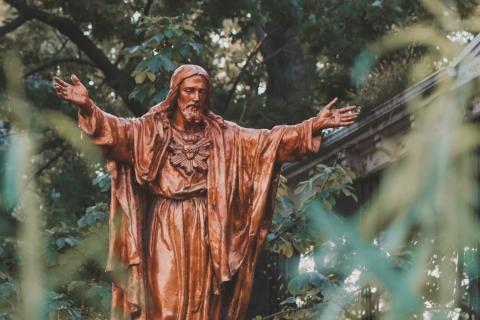
The following talk was given by Sister Thomas Welder, OSB, in September 2015 at a formation seminar for new faculty at the University of Mary.
The Benedictine spirit emanates from a person who lived in the sixth century: Saint Benedict of Nursia. Benedict grew up in the countryside but was sent to study the liberal arts in Rome. He became dismayed with the moral decline and chaos of the time, and so he escaped. But he didn’t go too far. Benedict became a hermit, probably for a couple of years. But there were other God-seekers in the region, and they called Benedict out of that life of solitude. And Benedict realized that the search for God goes a lot better when we do it with each other. So he and his sister, Scholastica, began to form small communities of women and men.
We need to be clear here that Benedict had no intention of starting a religious order. It happened very gradually; he felt called by God to bring people together in a search for Him through community, through prayer, through service to each other. A 20th-century Benedictine scholar, Jean Leclercq, says, “According to St. Benedict, monastic life is entirely disinterested. Its reason for existing is to further the salvation of the monk, his search for God, and not for any practical or social end.” Yet, quietly and patiently, Benedictine monastics transformed a collapsed Roman Empire, a world in ruins, through prayer and work. Saint John Henry Newman talks about this spirit by describing it as a restoration: without any drama, he explains, the monks could be found at work clearing fields, digging, and building, and other monks were doing their manual work in the form of art – copying and recopying manuscripts that they had saved from destruction. No work was greater than any other work. It was a disciplined way of life, energized by the regular, rhythmic round of prayer that led to the transformation of Western Europe during those chaotic days following the decline and collapse of the Roman Empire.
When you think about the individual in those times, there was a less developed sense for human rights and human dignity. You were a servant or you were in the upper class. And if you were in the upper class, you were served by those who were servants. But Benedict structured things so that age, wealth, social status – none of that counted. All that counted, if one wanted to be a part of Benedict’s community, was this question: “Are you seeking God?” It was countercultural. All were servants. All had dignity. It was a lifestyle, with a structure, within a common life, that worked against the spirit of that age and of a fallen humanity.
Obviously, this founding story is dated; it happened more than 1500 years ago. So what remains for us? The ethos. The ethos remains and is still valid for us today.
Here we turn to the founding of later Benedictine initiatives like the University of Mary. The Benedictine Sisters of the Annunciation were approved to live as an independent monastery from St. Benedict's in Minnesota in 1947, and already they loved the people of the prairie. They had been here as Sisters on mission since 1878. Bishop Vincent Ryan was the one who absolutely felt he had to have a community of Benedictine Sisters independently established here, so he began making visits to the motherhouse in Minnesota. St. Benedict’s Monastery at the time had more than a thousand members, and so he felt that they ought to be willing to spare some Sisters for a new monastery in western North Dakota. 140 volunteered. They had to sign up and be in North Dakota by June of 1944. Then they put in their appeal to Rome. It took three years but in 1947, on the eve of the Feast of the Annunciation, they were given papal approval as an independent monastery.
So it was in the early 1950s that the Sisters began looking around, paying attention to the needs of the people they loved. Here’s what they noticed: first, there wasn't a Catholic college between Helena, Montana, and the area of St. Cloud, Minnesota, where their Sisters had come from. Second, there wasn't a four-year college in the central part of North Dakota. Third, most of the founding Sisters were teachers and nurses, but most of the teachers in the region, particularly women, had a two-year standard degree. They knew that the legislature was soon going to demand a four-year degree for teachers. For nurses there had been a diploma program since 1915. But if the Sisters were going to prepare leaders, those nurses needed the liberal arts. So they had a vision that nurses, too, needed a four-year degree.
So as the Sisters were looking for ways to serve the intellectual, the religious, and even the cultural needs of the people of the area, they began thinking about a college. Interestingly enough, after some research, the Sisters voted to begin this new ministry. Mary College launched the year I entered religious life, in 1959. That was the year the Sisters moved into a brand new monastery, started the College, and started a small high school, Priory High. The College did not have a campus, so it shared part of the classrooms with the high school. And the Sisters resided at the St. Alexius campus at Boniface Hall, and a bus took them back and forth. We had 14 full-time students; we had 55 part-time students. The part-time students were all adult learners.
So when you think about how our founding Sisters described their charism, we sponsoring Sisters describe our charism in the same way. To this day we simply say, “We're the Benedictine Sisters of Annunciation Monastery. We seek God, and we live as a monastic community under a prioress according to the Rule of Saint Benedict.” That's the gift that has been given to us. That charism is what brings us together in our founding story; in the vision that our founders had to serve the academic, cultural, religious needs of the people in the region; in our common values; and then finally, in our ministry flowing from that charism.
Sister Elizabeth Novy was one of the founding Sisters, and her 100th birthday is next year. She taught first and second graders for 67 years. I asked her one day, “Sister Elizabeth, did you really teach school for 67 years?” She said, “Why would you stop something you really like doing?” One morning at breakfast, I teasingly said to her, “Sister Elizabeth, thank you for being such a great model of the monastic life.” She looked at me and said, “Now that I think about it, that's about all I got to do today!”
If you would have asked Sister Elizabeth what it was that she's grateful for and would prefer to be known for, she’d probably say, “For prayer, for gentle but solid teaching, for community, for my own Sisters, and for my parishes.” She always taught in parish schools and became very close to them.
So the faithfulness and the stability of Benedictines like Sister Elizabeth can be attributed to the monastic sense of an all-pervasive divine presence. In Chapter 19, Benedict says, “The presence of God is everywhere,” and that presence is celebrated daily in prayer, in Eucharist, in the common table, in hospitality, in the embrace of guests, our students, and all who come to the door of the monastery. And that's our acknowledgment of God's faithfulness to us, of the spark of the divine in every person we meet, and it owes much to the Bible, the Word of God. As Benedict says, “When you greet the guest, you greet Christ himself.”
In the very last chapter of the Rule of St. Benedict, in what some people call an epilogue of the Rule, Benedict asks, “What page, what passage of the inspired books of the Old and New Testament is not the truest of guides for human life?” In this same vein, in his address at the Collège des Bernardins in 2008, Pope Benedict XVI beautifully speaks about the search for God requiring a “culture of the word.” And he writes that whenever the monk or the nun sets out in search of God, they have already found the direction needed through the word of the Bible, in which they hear God himself speaking. He goes on: “So the monastic journey is indeed a journey into the inner world of the received word. Even if an infinite distance is involved,” like the journey to life everlasting, “within the monk's seeking, there is already contained, in some respects, a finding.” So within our search for God, through the word, in a sense we've already found God, because God has found us.
And so we're not surprised that the first words of Saint Benedict in the Prologue of the Rule are an invitation to listen to the word. Benedict was steeped in Scripture, and his model for a life of obedience to the word was Jesus Christ.
So here's how Benedict opens the Prologue: “Listen carefully, my child, to my instructions, and attend to them with the ear of your heart. This is advice from one who loves you; welcome it, and faithfully put into practice.” Sister Aquinata Bockman, who's a Benedictine Sister, teacher, scholar, and author, believes that listening aptly describes the spirituality of the entire Rule. Benedict reinforces this in the Latin he chooses. That first word is obsculta, a word for “listen” which is the Biblical metaphor for wisdom, and which calls for inclining your heart. And “to be inclined” or “to bend” always shows up in the Rule in the context of humility, which is Benedict’s way of referring to wisdom.
So the heart for Benedict not only designates the core of a person with its power of loving, but also the power of thinking. In listening with the ear of the heart, one is listening not only from a stance of faith, but also from a stance of the intellect, the integrity of the mind. He brings together faith and reason in the search for truth. Here I quote Leclercq: “In the search for truth, bending the ear of your heart safeguards the integrity of the mind.” This is the humility of reason.
That idea is given some clarity in Ex Corde Ecclesiae: “It is in the context of the impartial search for truth that the relationship between faith and reason is brought to light and meaning.” So that search for truth, the relationship between faith and reason, is brought to life in me. And listening with the ear of your heart is the power of loving, the power of believing, the power of obeying, and the power of thinking and reasoning.
In Saint Benedict's summary of the Prologue, he says, “Therefore, we wish to establish a school of the Lord's service.” Pope Benedict points out that Saint Benedict wasn't speaking specifically about schools as we would know them, “although in practice he presupposes teaching and learning.” Benedictine monasteries have an instinct for learning. In Chapter 3, “On Seeking Counsel,” Benedict writes that the prioress calls together the entire community when she has issues that require resolution. She listens to the entire community, and, Benedict says, “particularly to the young.” She listens particularly to the young because sometimes the Spirit reveals to the young what is not observed by any other remember of the community. And it’s in Chapter 48, “On the Daily Manual Labor,” that Benedict directs that the monks should not only have specified periods for manual labor, but also two to four hours for prayerful reading and study. This we call lectio, the reading of the word, reflecting on the word. So that learning instinct is embedded in monastic culture.
The fundamentals of monastic life are prayer, work, study, and relationships, but the way a monastery is a school is not the same as the way our university is a school. Yet there's a fit between these monastic fundamentals and our six core Benedictine values. I like to put them in clusters when I visit with students. Community, respect, and hospitality: they’re all about relationships. And then I take the next three values: prayer, service, and moderation. They’re all about relationships as well! Prayer is about our relationship with God; service is about our relationship with each other; and moderation is about the relationship we have within ourselves, how we find that balance in our lives. Some writers refer to Benedict's ordering of the day as his genius. It's built in a way that we can test ourselves and how balanced our life is. For instance, if I do not have time for prayer, if I do not have time for lectio, what has happened in my life? Because there's one thing I can be sure of in a monastery: the schedule for common prayer never changes. But then there has to be a place for private prayer, for service, for ministry, and so on. But Benedict gives us the framework. He talks about finding that balance that feeds the mind, the body, and the spirit. Thomas Merton says, “Happiness is not a matter of intensity, but of balance, order, rhythm, and harmony.”
So as we think about that Benedictine charism – seeking God through life in community – we think about the intellectual and wisdom tradition of our Catholic and Benedictine tradition. We reflect upon faith and reason. It is helpful then to go back again to Pope Benedict’s address to the ministers of culture at the Collège des Bernardins in Paris. He points out that the monastery takes a holistic approach, engaging the whole mind and the whole spirit. Benedict says that the ultimate aim of formation “is that man should learn how to serve God,” but it also includes the “formation of reason,” which he calls, “education … through which man learns to perceive, in the midst of words, the Word itself.” So the basic theme of the Rule is that human beings are oriented to relationship with God, to the truth, to the Word itself. And that view brought the founders of the University of Mary to state their goal in this way: to prepare students to become leaders in the service of Truth.
The Rule recognizes that each student moves toward wholeness and holiness at their own pace, but in order to experience both formation and education, listening is essential. Perhaps the best way to describe the environment of a Benedictine school is to name it a place where people truly listen to one another, where diverse views are respected, where the teacher is not so much the expert in their discipline, but the co-learner. Students are listening to their teacher, teachers to their students and their colleagues, and all sit at the feet of Christ, the quintessential teacher. To be a community is to learn from each other. Pope Benedict talks about the “pilgrim fellowship of faith.”
The freedom which comes with the truth develops out of discipline, which is one of our hallmarks. So freedom is not only an intellectual act, but it's a responsible act modeled on Christ, Christ who perfectly reveals God as the source of love and freedom. Pope Benedict talks about the tension between obligation and freedom, and he speaks of freedom as an obligation of insight and love. I think we can easily translate that as an obligation of service.
Here’s a quick story. I was speaking to a freshman class back when I was president, and I was trying to introduce the idea of servant leadership. When I finished, one of the students, Rachel, came up to me and said, “Sister, this servant leader concept that you're talking about is an oxymoron. It doesn’t make sense. A servant is always in the background, and a leader is in the spotlight. I don't get it.” She was an English major, and soon enough I see that she had written an opinion column in the student newspaper, and it was entitled “Servant Leader, the Great Oxymoron.” She wrote about how, in our day and age, the very idea didn’t make sense. Why would we even get tangled up in it? Because typically when you think of leader, you think of somebody with status, somebody who's aggressive, somebody who's out there climbing a ladder to some kind of success, whether it be economic or social. But then she offered a small event that happened in her life, where she observed something in the residence hall. One of the young women living across from her didn’t come out of her room one morning. She always came out of her room at 8:00 a.m. Rachel didn't think anything about it. But another girl down the hall did. And this other girl came knocking on her door: the student was sick. Rachel later discovered that this Good Samaritan student made sure the nurse knew her neighbor was sick; she called all her professors and said she wouldn’t be in class that day; she made sure she got breakfast and tended to the needs of that student at that moment. What astounded Rachel is that this young woman had no title and no responsibility. She wasn't the RA. She wasn't an RD. She really didn't even know this student.
Rachel wrote, “I get it. That's servant leadership. That's putting service first. That young woman didn't have leadership in mind at all. But she gave a powerful witness.”
So, a Benedictine academic environment encourages a willingness to trust the truth. And that kind of environment, while deeply religious, is never sectarian and never fundamentalist. And here I'm quoting Father Demetrius Dumm, who was a Benedictine biblical scholar and theology teacher at St. Vincent's in Latrobe, Pennsylvania. He observes that Benedictines, whose tradition precedes all the divisions of Christianity, find ecumenical dialogue congenial and fruitful. Benedictine theology has always been biblical and contemplative rather than polemical. So in the academic setting, discussions and debates begin with the assumption that reasonable people who honestly seek the truth need not become strained or hurtful in their presentations. William Isaacson wrote about what we can do in our country today in terms of finding some way that we can be reasonable and listen to each other. And he pointed this out: “In most dialogues, we don't listen; we just reload!” He means that we come in with a position that we are absolutely convinced of, and as a consequence, we can't listen; we don't have that ear of the heart. Maybe this is why the word peace appears so often in Benedictine settings.
In any case, from about the eighth to the twelfth century, Benedictines found themselves to be the only educators in Europe. The monastery was virtually the only stable institution as Western Europe was gradually coming back to its own. So it was the only institution where you could have an extended education. The monks taught their students to read, and the text was the Bible. But if the real goal was to read the Bible with understanding, then of course it would be helpful to be versed in literature and the authors of the day, including the manuscripts the monks had preserved from antiquity. They were absolutely committed to that – committed to the liberal arts – because the Bible is human literature as well as the word of God. Pope Benedict explains with that same logic that just as we studied the biblical word to penetrate and understand it, so the path is open to the secular sciences, which show us pathways to the word.
Ultimately, I quote again from Pope Benedict, “If a way is to be opened up into the heart of the biblical word as God's word, this word must first of all be proclaimed outwardly.” We need witness, goodness of life. He continues: “The novelty of Christian proclamation does not consist in a thought, but in a deed: God has revealed himself. Yet this is no blind deed, but one which is itself Logos – the presence of eternal reason in our flesh. Verbum caro factum est: just so, amid what is made (factum) there is now Logos, Logos is among us. Creation (factum) is rational. Naturally, the humility of reason is always needed, in order to accept it: man’s humility, which responds to God’s humility.” So with that kind of unwavering hope – that the Logos is among us – we run on the path of God's commandments towards the ultimate meeting with Christ himself.
The search for God, and the readiness to listen to God, is the Benedictine charism of the University of Mary.


